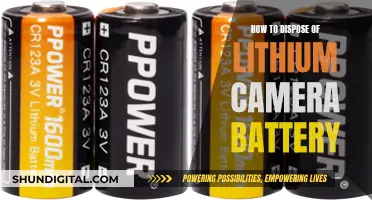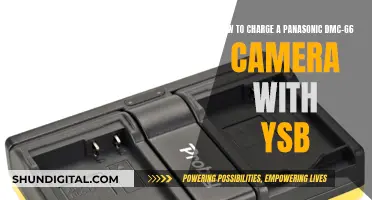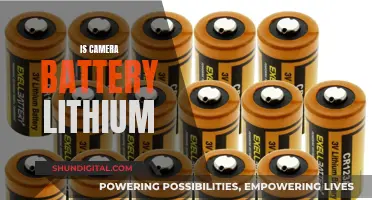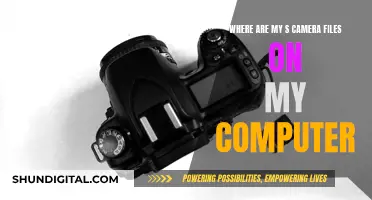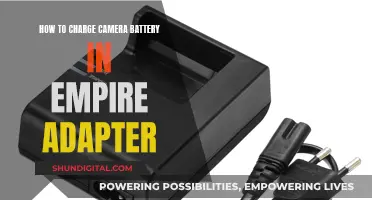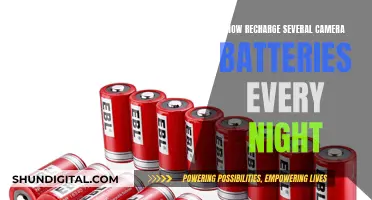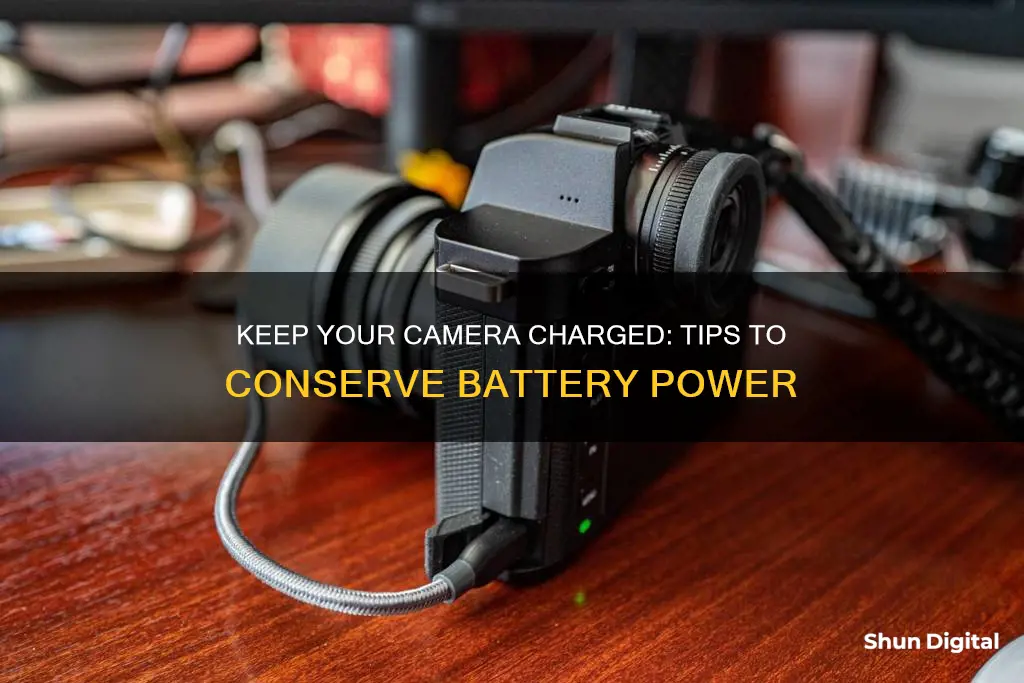
As a photographer, there's nothing worse than a camera dying mid-shoot. Luckily, there are several ways to avoid losing battery power and ensure you can capture every moment. From turning off your camera when not in use to storing batteries correctly, this article will cover everything you need to know about maximising your camera's battery life.
What You'll Learn

Turn off the LCD screen
The LCD screen is one of the biggest drains on a camera's battery life. This is because the LCD screen is used to preview and review photos before and after they are taken. Therefore, one of the best ways to avoid losing power in your camera is to turn off the LCD screen.
If you are unable to stop using the LCD screen altogether, there are some other things you can do to reduce the amount of power it uses. Firstly, you could disable post-shot reviews. This will stop you from reviewing photos immediately after taking them, which will save some power. Another way to reduce the power used by the LCD screen is to lower its brightness setting. This will make photography a bit trickier in bright conditions, but it will also save power.
If you are using a DSLR camera, you can avoid using the LCD screen altogether by switching to the optical viewfinder. However, if you are using a mirrorless camera, you will have to keep the LCD screen on in order to take photos. In this case, you can still save power by turning off the camera frequently or setting it so that the LCD screen only activates when you hold it up to your eye.
In addition to turning off the LCD screen, there are some other things you can do to avoid losing battery power in your camera. For example, you can avoid using features like automatic flash and continuous autofocus, as these use a lot of power. You can also try to avoid scrolling through stored photos or cycling through the camera's menus, as this will also drain the battery.
Is Your Fujifilm Camera Charging? Here's How to Know
You may want to see also

Enable power-saving mode
Enabling power-saving mode is a great way to ensure your camera's battery lasts longer. This feature is available on most camera models and can usually be found in the camera's settings. Here's how you can enable and make the most of power-saving mode:
Enabling Power-Saving Mode:
- Check your camera's manual to locate the power-saving settings.
- Access the settings menu and look for options like "Power Saving Mode", "Eco Mode", or "Battery Saving Mode".
- Toggle the setting on to enable power-saving mode.
- Some cameras may have an Auto Power-Saving Mode that automatically activates power-saving features after a period of inactivity. You can choose to enable this or manually activate power-saving mode as needed.
Maximizing Power-Saving:
- When power-saving mode is enabled, the camera's screen will often be dimmed or turned off to conserve power.
- Avoid using the LCD screen excessively. Instead, use the viewfinder to frame your shots and reduce screen time.
- Lower the brightness of your LCD screen when possible.
- Disable features you don't need, such as automatic flash, continuous autofocus, and sound effects.
- Keep your camera and batteries warm when shooting in cold environments. Cold temperatures can decrease battery performance.
- Regularly check your camera's settings to ensure power-saving features are active and optimized.
By following these steps and enabling power-saving mode, you can effectively extend your camera's battery life and ensure you don't miss any important shots due to a drained battery.
Outdoor Wi-Fi Camera Battery Life: How Long Does It Last?
You may want to see also

Avoid cold temperatures
Cold weather can cause a battery to perform below its projected lifespan. It won't hold its full charge if it's stored in a cold location. A drop of 10 °C (18 °F) can cause your battery life to deplete by as much as half.
- If you must shoot in cold conditions, carry the battery in a pocket close to your body. Body heat will keep it warmer than if it were inside the camera.
- Keep your camera in its case when you are not using it to take pictures. Exposed to the air, frost may build up which could obscure the viewfinder or lens or find its way inside, particularly when you focus, zoom or operate any dials.
- Carry a spare battery or batteries and keep them warm until needed. Inside your clothing, in an inner pocket that is reasonably easy to reach while outside in cold conditions.
- Put the lens cap in place when the camera is not in use. It will help prevent condensation and frost from forming on the front of the lens.
- If you have to change lenses, do it quickly and in a semi-open jacket, protecting the camera from the wind.
- Returning indoors with cold camera gear? Leave your gear in the bags or case for a few hours or longer until it has warmed up, and keep the bag closed and zipped while still outside in the cold. If you take it out too early, condensation will form on the camera and lens surfaces.
- Do not warm up your batteries too quickly. If your batteries are freezing cold, be sure to warm them up slowly with body temperature or with time inside a warm room. Do not put them too close to a heat source like a fire or heater, as you can damage the battery permanently.
Charging the 808 Keychain Camera: A Quick Guide
You may want to see also

Replace old batteries
Rechargeable batteries lose their ability to hold a full charge over time, so if your camera battery is a few years old, it might be time to replace it. This is completely normal behaviour, but it does mean you should be careful of relying on older batteries.
Labelling your batteries with their age can help you keep track of how old they are and which ones are losing their ability to hold power. If you have friends who shoot with similar camera systems, labelling your batteries can also make it easier to keep track of whose batteries are whose.
If you can't get much use out of your old batteries, it might be time to retire them and buy a new one. You could also consider buying third-party batteries, which can save you money, although they may not be compatible with your camera.
If you're looking for a more cost-effective solution, you could try buying a few spare batteries to ensure you have enough power for a project.
Is Your Camera Battery Charged? Check This Way
You may want to see also

Avoid using the flash
The flash is one of the most power-intensive features of a camera. It is a device that emits a short burst of bright light, typically lasting between 1/1000 to 1/200 of a second, to illuminate a dark scene.
- Use ambient lighting: If possible, try to take advantage of natural light sources such as windows or lamps. By using the available light in the environment, you can reduce the need for artificial lighting from the flash. This is especially useful during the day when natural light is more abundant.
- Adjust camera settings: Play around with different settings on your camera to reduce the need for flash. For example, you can increase the ISO setting, which will make your camera's sensor more sensitive to light, allowing you to capture well-lit photos even in low-light conditions.
- Use a tripod: When shooting in low-light conditions, consider using a tripod to stabilize your camera. This will allow you to use longer exposure times without worrying about blurry images due to camera shake. By avoiding the use of flash, you can conserve battery power.
- Experiment with shutter speed: In certain situations, you can try using slower shutter speeds to let more light into the camera sensor. This is especially useful when photographing stationary subjects or when your camera is mounted on a tripod. However, be mindful that slower shutter speeds may result in blurry images if your subject is moving.
- Use external lighting: Instead of relying solely on your camera's flash, consider using external lighting equipment such as LED panels or studio strobes. These can provide a continuous light source, reducing the need for the power-intensive flash.
By following these tips and being mindful of your camera's settings, you can avoid using the flash and prolong your camera's battery life.
Camera Batteries: Do They Have an Expiry Date?
You may want to see also
Frequently asked questions
There are several ways to avoid losing battery power in a camera. Firstly, avoid using the LCD screen for framing photos, as it consumes a lot of power. Instead, use the viewfinder if your camera has one. You can also reduce the brightness of the LCD screen to save power. Secondly, disable features you don't need, such as automatic flash, continuous autofocus, and image stabilization. These features use a lot of battery power, so only enable them when necessary. Thirdly, keep your camera turned off when not in use, and avoid turning it on and off repeatedly, as this can drain the battery. Fourthly, keep your batteries warm when shooting in cold environments, as cold temperatures can reduce battery performance. Finally, carry spare batteries with you, so you can always swap to a fully charged battery if needed.
To conserve battery power when using the camera's LCD screen, try to reduce the amount of time the screen is on. Avoid reviewing photos on the LCD screen for too long, and disable post-shot reviews. Additionally, lower the brightness of the LCD screen, as this can help extend the battery life.
The autofocus feature uses tiny motors to adjust the focus, and these motors consume battery power. Continuous autofocus is the biggest drain on battery life. If you don't need continuous autofocus, you can switch to one-shot or autofocus single mode, which uses less power.
The camera flash can drain a lot of battery power, especially if it is used frequently or in rapid succession. To reduce its impact on battery life, only use the flash when necessary, and try to use alternative lighting or adjust exposure and ISO settings instead. Additionally, disable automatic flash if you don't need it, as this can help conserve battery power.
Extreme temperatures, especially cold, can significantly reduce camera battery life and performance. To optimise battery life, avoid using the camera in very cold or hot environments. If you must shoot in cold conditions, keep the battery warm by carrying it close to your body, such as in an inside pocket of your clothing. This will help the battery maintain its charge for longer.


